Researchers, physicians, pharma, and biotech developers all want to do the right thing for patients. Everyone in the industry understands the need to develop transformative therapies for those with disease. But historically, patients have often been invisible.
Although patients are the ultimate customers, companies would only deal with prescribers and payers. Within drug development,  companies would work with patients through intermediaries such as principal investigators and patient groups. Because of this, companies didn’t always think reflexively about patients’ needs.
companies would work with patients through intermediaries such as principal investigators and patient groups. Because of this, companies didn’t always think reflexively about patients’ needs.
This paradigm is changing and a culture shift is occurring within the industry. Companies large and small, regulators, and even new laws are aiming to put the patient truly at the center of drug research and development.
The industry had lost sight of its impact on patients, says Jeremy Levin, D.Phil., CEO of Ovid Therapeutics.
“The industry had divorced itself from truly understanding the intimate link between what a company does and what the patient needs and our obligations to the patients and their caregivers," he says.
Today, companies are changing their mentality from simply selling drugs to interacting with patients. That changes how companies think about developing new drugs.
“A very strong relationship between a company and a patient is pivotal and essential to success," Dr. Levin says. “In order to follow through on that commitment, drug developers need to understand how the disorder impacts the patient and develop ways to significantly assist the patients and, where relevant, their caregivers."
Previous efforts to engage patients in drug development were not always effective. In the past, researchers asked patients for comment on study design but that model did not work, says Aiman Shalabi, Pharm.D., chief medical officer at Cancer Research Institute, a nonprofit organization developing immune system-based strategies to prevent, diagnose, treat, and eventually cure cancers.
“Protocols are incredibly complicated, they’re technical, they’re scientific, and it’s difficult to get a lay person to provide any meaningful feedback," he says. “We’re in a new era; we have to look beyond the traditional thoughts of patient centricity just being around the design of trials to patients being involved every step of the way."
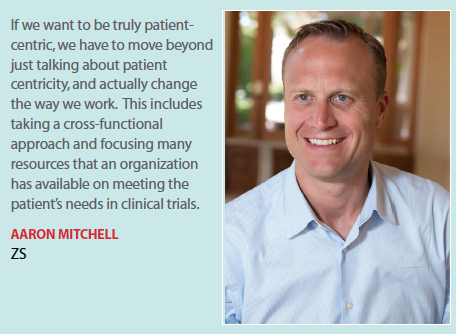 Dr. Shalabi adds that patients need to be involved in more of the steps of the drug development paradigm.
Dr. Shalabi adds that patients need to be involved in more of the steps of the drug development paradigm.
“Patients need to be actively engaged in the science, particularly in the case of immunotherapy," he explains. “We should expand our thinking about patient centricity beyond the clinical trial design to the drug development continuum from beginning to end — from the scientific concept to the design to the execution — and engage patients in managing their own therapies."
Elliott Levy, M.D., senior VP of development, at Amgen, says his company has invested in learning from patients what makes a medicine useful for them.
“We’ve intensified our focus on finding ways to better evaluate the effects of drugs from the patient’s perspective, not just from the perspective of the regulator or the payer," he says.
One example of the company’s insights into how patients interact with one of its drugs involved Neulasta, a supportive therapy for patients undergoing cancer chemotherapy. The company learned that patients had difficulty returning to the clinic the day after their chemotherapy to receive Neulasta, which is used to help reduce the chance of infection due to a low white blood cell count. High-dose chemotherapy can often leave patients feeling fatigued and in pain. Amgen found that in some cases patients were receiving Neulasta off schedule or not at all.
To better assist patients, Amgen developed and deployed the Onpro injector, which allows patients to administer the medication at home.
“This automated device allows patients to receive the drug at home on schedule without having to return to the physician’s office," Dr. Levy says. “We have heard from patients that this is a significant advance that improves the experience with undergoing treatment."
Moving Beyond the Buzzword
Aaron Mitchell, principal at ZS, says companies have to move beyond the buzzword of patient-centricity.
“Being patient-centric will allow companies — if they sustain it — to best position their clinical trials not just with more patients but also with the investigators who are leading the trials at the point of care," he says.
Patient-centricity is still a relatively new concept for the industry so there is going to be an evolution of methods, says Jill Platko, 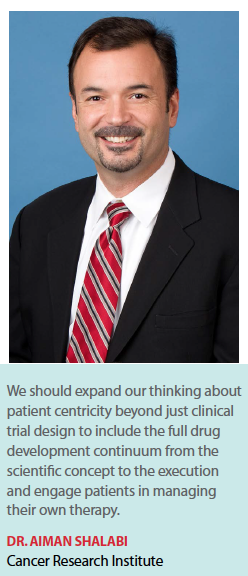 Ph.D., senior scientific advisor at CRF Health.
Ph.D., senior scientific advisor at CRF Health.
“New practices need to be tested and then rolled out," she says. “There is a lot of learning involved to truly understand patient needs and to find the best solutions. It’s difficult for many study teams to add new activities to the study set-up phase when they are already very busy. We have seen sponsors start to use incentives with study teams to motivate them to use innovative methods, which may be a good way to drive change."
It’s not just sponsors that need to be more patient-centric. Support companies also need to up their approaches to make sure all that can be done for patients is being done. For example, CRF Health has implemented oncology studies that included strategies to allow the participants to complete their questionnaires at home when they were too ill to attend the site visit.
“We have seen that compliance with completing these assessments at home is nearly the same as it was at site visits suggesting that the participants remain engaged whereas we know from sponsors that we work with that post-progression compliance tends to be very low," Dr. Platko says. “We have also had success using eCOA devices for studies requiring close communication between the subject and the site."
Industry experts say patient-centric programs can help identify the right treatment targets, streamline clinical trial design, enhance patient enrollment, and improve site performance.
Mr. Mitchell says being patient-centric means you need to move beyond the clinical trial protocol; it revolves around clinical trials that deliver a positive patient experience that extends beyond the trial into the real world.
“We need to truly understand the experience that patients have — not just the experience during their clinical trial journey but the broader experience they have with their disease," he says. “A clinical trial needs to fit within the broader journey the patient is taking through their disease and needs to be compatible with the overall healthcare ecosystem that is delivering care to the patients. The clinical trial has to be designed in a way that is a good care option for patients and can be well supported by the sites and other stakeholders supporting the trial and is not a square peg in a round hole."
In 2016, ZS conducted interviews with patients across eight disease areas and with pharmaceutical executives. A majority of pharmaceutical company executives appreciate that patients should be the center of drug development. But getting patient-centricity right has proven to be an elusive goal, according to the ZS study.
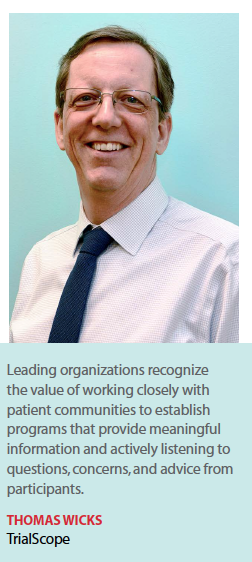 Mr. Mitchell says being patient-centric is difficult for pharmaceutical companies because of the processes and approaches companies use to design and execute clinical trials.
Mr. Mitchell says being patient-centric is difficult for pharmaceutical companies because of the processes and approaches companies use to design and execute clinical trials.
“It’s quite difficult to move the entire organization in the direction of patient-centricity when the process has been done a certain way for so long," he says. “There may not be a centralized organization that is responsible for driving patient-centricity within pharmaceutical and biotech organizations, so patient centricity is usually left to the individual clinical development leads or teams to find their own way. Even in companies that do develop a centralized initiative, that organization doesn’t necessarily have the mandate required to drive change and/or it may not actually have the level of funding or even resources to support change."
Additionally, a lack of dollars contributes to the challenge. When budgets or timelines get tight, patient-centric initiatives are some of the first things to go.
In some companies, Mr. Mitchell says, patient-centricity has devolved into just another item that needs to be “checked off."
“True patient-centricity recognizes that every disease and every trial is unique and one-size-fits-all solutions can’t be expected to work in every case," he says. “For example, remote monitoring of patients for one disease may work but it may not necessarily work for another. Patient services that address one disease might not work for another. In some trials, we need to do more than just bring in a patient advisory group to provide input. In many cases we may need other types of research with patients, such as ethnographic research or research to explore the emotional impact of the disease or treatment on the patients."
Pharma companies are beginning to understand the value of engaging with patients in trial design to ensure that some of the outcome measures are meaningful to the participants, says Thomas Wicks, chief strategy officer at TrialScope.
“We know we need to have a vehicle to communicate with and listen to patients," he says. “Programs are evolving and expanding as trial sponsors are willing to experiment with new ways to communicate throughout the research life cycle and beyond."
Pharma’s Efforts Toward Patient-Centricity
Dr. Levy says Amgen’s commitment to involving patients in the design of clinical trials, including in the selection of endpoints, is strong. The company recruits a panel of patients who can advise on the selection of study endpoints and study design features so that the study is of interest and the burden of trial participation is minimized.
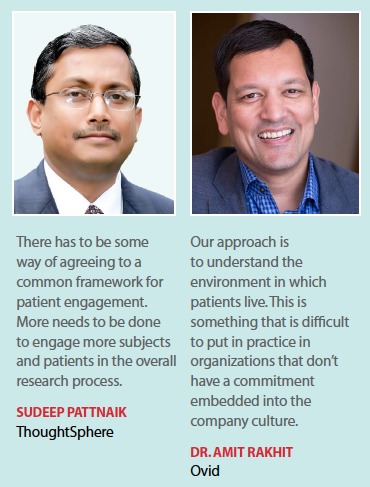 “In some cases we might reach out to patients to perform a trial simulation; we act out the activities that are involved to provide patients with insights into the study conduct that can’t be done any other way," he says. “This approach often allows us to simplify or improve the trial design so that it’s easier for patients to participate, they’re more willing to join the trial, and they’re more likely to stay in the trial once they have been recruited."
“In some cases we might reach out to patients to perform a trial simulation; we act out the activities that are involved to provide patients with insights into the study conduct that can’t be done any other way," he says. “This approach often allows us to simplify or improve the trial design so that it’s easier for patients to participate, they’re more willing to join the trial, and they’re more likely to stay in the trial once they have been recruited."
To assess the success of patient initiatives, Amgen is using intermediate or leading indicators. The company is assessing efforts to reduce the burden of participation and implementing novel trial methodologies to facilitate patient involvement. Amgen also is conducting virtual trials, such as studies in migraine where researchers studied a group of patients without any physical contact. The patients were recruited virtually, provided their consent virtually, and the data were gathered by patients using wearable devices.
“We’re very interested in approaches that will potentially allow us to include a much larger and more diverse group of patients in our trials and improve the relevance of the data that we collect," he says.
Novartis is another company that has made a commitment to be patient-centric. In June 2015, Novartis introduced its Patient Declaration. Developed with the involvement of a number of international patient organization advocates, the declaration formally states what patients can expect from the company. The declaration outlines the company’s commitments in five key areas: access to innovative medicines; patient safety; respecting the patient perspective; data transparency and data integrity; and clinical trial input.
Being patient-centric is a broad concept, says Cathryn Clary, M.D., head of patient affairs in global development at Novartis.
“Patient-centricity starts at the beginning, having a deep understanding of how patients experience their disease and understanding the symptoms," she says. “This understanding needs to start even before drugs are in full development. As drugs undergo early testing or even before we put the drug into humans, we need to understand the disease and develop good outcome measures that reflect what’s meaningful to patients."
Dr. Clary’s department was formed to develop a systematic approach to getting the patient voice and patient insights into Novartis’ drug development programs, as well as writing and executing on policies that are patient-focused.
“There was an enterprisewide commitment made publicly specifically by our senior leadership on behalf of patients," she says.
One of the first things Dr. Clary’s group did was determine where the company’s development organization was in terms of patient engagement. They found there were certain obstacles preventing more rapid uptake, including concerns about budget and regulatory issues as well as a general lack of understanding about how to compliantly reach out to patient groups.
“Our group started just as Novartis was going through a major organizational change within global drug development and bringing the divisions together," she says. “We developed enabling and supporting tools for our drug development teams. And we are just about to launch a number of these tools. In the meantime, we’ve served as a center of expertise for teams when they have questions."
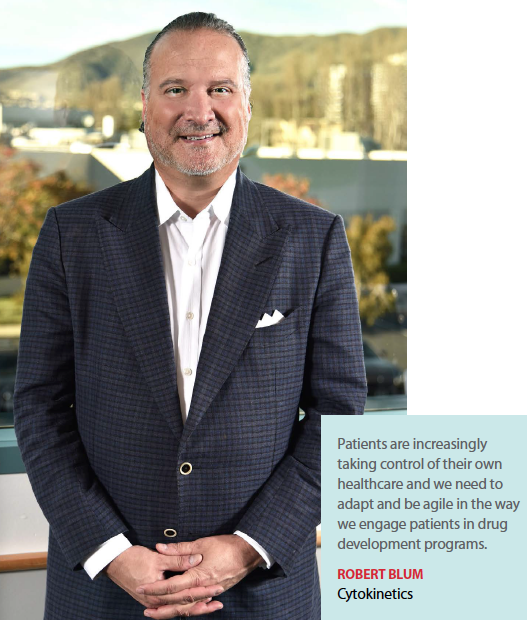 Novartis is developing a gap assessment guide, which is a tool that drives and inspires a facilitated discussion with a multifunctional team so that it can understand what unique information they need from patients.
Novartis is developing a gap assessment guide, which is a tool that drives and inspires a facilitated discussion with a multifunctional team so that it can understand what unique information they need from patients.
Another tool is a trial feedback questionnaire for patients involved in trials. This was developed with input from patients and is being piloted now, Dr. Clary says.
“Within the industry, it has been rare to ask patients who have been part of a trial what they think about their experience," she says. “This particular questionnaire can be given at three times: after the patient signs the informed consent, in the middle of the trial, and at the end of the trial. This will enable us over time to see how we’re doing in terms of the execution of the trial and work with our investigative sites on any adjustments that need to be made."
The company plans to include metrics into its clinical trial management system to assess whether a program engaged patients and what techniques were used. Other programs include a compliance guide, case studies, and tracking and measuring tools to evaluate patient engagement.
Achieving True Patient-Centricity is a Challenging Goal
A recent survey conducted by the Drug Information Association found that there is a disconnect between the C-suite and those within the development organization actually involved with implementing patient engagement strategies. At the C-suite level, patient engagement has been discussed in policy circles for a while now. Additionally, there is no standard way of incorporating patient engagement in clinical development.
“There is a lot of interest and momentum — and potentially even a mandate — at the C-suite around patient-centricity, but the C-suite doesn’t necessarily understand what patient-centricity means at the clinical trial level and how to make it happen," Mr. Mitchell says.
Each company will have to build its bridge to those patients; and each company will have to embed the culture that specifically dictates a patient engagement strategy in all their operations, Dr. Levin says.
“This can be extremely difficult," he says. “Larger organizations with tens of thousands of employees and many years of established culture may not be able to adopt or evolve a new culture in the short term or even the mid term. Smaller companies that may or hope to become larger companies will be able to more easily embed being patient-centric in their culture from the beginning."
In larger corporations, there may be competing priorities or different perspectives — sometimes the patient voice gets crowded out by other voices, says Amit Rakhit, M.D., chief medical officer at Ovid Therapeutics.
“Our approach to clinical development starts from the beginning; we focus on the needs of the families and their children who would potentially benefit from our compounds, and then go beyond that to understand the environment in which they live," he says. “This is difficult to put into practice for organizations that don’t have a patient commitment strongly embedded into the company culture."
Ovid has developed close relationships with patients, caregivers, families, disease foundations, and thought leaders to better understand the history of the rare disorders it is focused on and to raise awareness, identify patients, and facilitate enrollment of clinical trials. Ovid regularly brings in patients and families into its offices in New York and identifies clinically meaningful endpoints based on input from patients, families, physicians, and caregivers.
For example, through social media Ovid learned that there was a previously under-recognized Angelman syndrome symptom: children with Angelman syndrome have problems sleeping. Various sleep parameters are now endpoints in Ovid’s clinical trial of OV101 called STARS. Angelman syndrome is a rare genetic disorder that mainly affects the nervous system and development.
“Part of what we do at Ovid is to establish an understanding of the natural history, a deep grounding, and understanding of the fundamental aspects of the disorder and how that affects patients lives," Dr. Levin says. “It’s a tremendous investment, but it brings huge dividends in our ability to competitively understand the needs of patients in terms of how a drug might affect them and, longer term, how this affects our ability to better enhance our clinical trials and pipeline."
“We’ll go visit families and spend a day or even a couple of days with them to understand what their life is like," Dr. Rakhit says. “We invite patients to our offices so they can meet our staff and understand what we’re doing."
Dr. Rakhit says before the trial for its OV101 compound began, they asked key people within the Angelman syndrome community to provide input into specifics about the clinical trial protocol; inclusion and exclusion criteria; how many visits was appropriate; the schedule of events and the timing of the therapy as part of the trial; and any travel or special needs that might need to be addressed.
“Today, as we are continuing to conduct this study, we are reaching out at regular intervals so that the community is aware of what is happening," he says. “Also, our families know what’s going on with the study through various means, including webinars through the patient advocacy channels, newsletters, and general communications through the sites that are involved," he says.
Dr. Shalabi of CRI says a key part of being patient-centric is making trials more accessible to patients.
CRI’s efforts include a clinical trial finder that helps patients diffuse all of the thousands of studies to be more helpful for patients.
“Patients are able to evaluate study options outside of their center and their geographies with not just the clinical trial finders but through the expert networks that we’re creating that have a global reach," he says. “We’re actively communicating what we know and our engagement of the science through the patient finder, live forums, and patient education forums where the experts are providing their information. Those programs have been quite successful, and we are able to identify other needs. We are nimble enough and flexible enough that we can adjust as needed."
Simple changes to processes can make a huge difference for patients, says Sudeep Pattnaik, founder and CEO of ThoughtSphere.
“For example, on consent forms, there is a lot of technical and legal language that patients may not understand," he says.
“Something as simple as making the informed consent form easier to understand can engage patients."
Patients are often desperate for access to new medicines. This urgent demand must be balanced with appropriate rigor required to assess technologies and novel drug mechanisms and a more concerted and genuine interest to elevate the patient voice, says Robert Blum, CEO of Cytokinetics.
“Sponsors can become myopic and overemphasize the novelty of mechanisms or biology," he says. “But that can take those companies down a rabbit hole where they may not always be developing their investigational medicine in a way that’s properly in tune with the needs of patients. The sponsor needs to engage the patients in an authentic way to best understand what matters most to them."
Cytokinetics, which is focused on diseases that are characterized by compromised muscle function, such as ALS, heart failure, spinal muscular atrophy and COPD, is working with patient advocacy groups to develop new types of assessments for use in clinical research.
Cytokinetics recently started a trial enrolling patients with ALS in which exploratory endpoints will be measured via an app that can collect real-time self-assessments made at home by the patient. The company’s next-generation drug candidate, CK2127107, is being studied in a Phase II trial that is incorporating an app that measures speech performance, enabling the company to assess a novel method of measuring effects on important verbal communications.
“These assessments can be quite physically demanding," Mr. Blum says. “We are trying to see if we can lessen the burden on the patient both in terms of travel to a clinical site and the physicality of those assessments." (PV)
~~~~~~~~~~~~~~~~~~~~~~~~~
The Challenges of Patient-Centricity
Buzzword burnout. Years of discussions of patient-centric ideas have created a counterproductive byproduct; some in the industry are growing weary of hearing the phrase.
Regulatory issues vs. patient demands. Patients want to have support groups for active participants in clinical trials and would prefer to receive ongoing updates regarding how trials are progressing and would welcome practical ways to improve trial convenience. But to avoid bias or decreasing scientific rigor, sponsors are unable to honor many of these requests.
Difficulty in measuring traditional ROI. Though companies believe that patient-centricity initiatives should be more common, such initiatives remain a luxury item in budgets. Executives explain their reluctance by citing the difficulty in applying quantitative metrics to measure ROI.
Balancing multiple internal and external stakeholders. Some companies have trouble identifying the most influential stakeholders as the healthcare ecosystem evolves.
Source: ZS
~~~~~~~~~~~~~~~~~~~~~~~~~
One Patient’s Experience with Clinical Trials
In 2010 at the age of 20, just before her junior year of college, Ariella Chivil was diagnosed with Hodgkin’s lymphoma. She initially tried various chemotherapy drugs before undergoing radiation — all while balancing her schoolwork — but these therapies eventually failed. This led Ms. Chivil and her doctor to begin looking for clinical trials for which she might be eligible. After completing 14 different treatment protocols, Ms. Chivil and her doctors decided to try a clinical trial for the immunotherapy Opdivo. Her first scans after beginning the trial showed a marked reduction in her tumors. Two years later, Ms. Chivil was off treatment and working in New York.
The process to find a trial, she says, was manual and burdensome.
“I visited different trial sites and talked to different physicians in an attempt to see what trials I would qualify for and what would be a good fit for me," she says. “There was a lot of uncertainty. There was a lack of transparency all around when it came to getting information about clinical trials and figuring out what was available, what I would qualify for, or what cohorts were in fact open. Even though the listing on clinicaltrials.gov might say a trial is recruiting, that doesn’t necessarily mean that there is a space for a given patient at that given time. Coordinating that knowledge, gaining access to physicians, and traveling was a time-consuming process."
She suggests basic information be available through an online portal that could provide a mini-triage for patients.
“On clinicaltrials.gov, there is a phone number that you can call that might put you in touch with a hospital switchboard or receptionist," she says. “Then you might play phone tag with the physician or clinical trial coordinator. The No. 1 thing that I struggled with was that trial information was not up to date or seemed to be inaccurate."
Additionally, Ms. Chivil advocates for a more friendly and approachable manner that is able to accommodate patients’ schedules and the burdens of participation. She cites one trial where she had to have a PET scan five days in a row. This required driving to the site, waiting to have the scan performed, and then having the scan itself done.
“I was lucky that I had parents who were by and large available," she says. “They would adjust their schedules for me. Many people aren’t as lucky. At one point I was undergoing radiation in Hartford while trying to do an internship, and while the hospital was only two or three miles away from my work, because I didn’t have a car I was taking cabs. It was only later that the social worker put me in touch with ride volunteers who would have given me a ride to my internship. Many patients don’t know that there are resources to help with things like this."
She suggests more patients would be interested in clinical trials if patients’ needs were able to be addressed.
“To the extent that clinical trials can be more flexible, engage with patients, and incorporate patient feedback before the trial, during the trial, and after the trial, would mean a lot to people," she says.
Furthermore, Ms. Chivil says it would be helpful if medical jargon could be translated in a way for patients to understand.
~~~~~~~~~~~~~~~~~~~~~~~~~
Advancing Science Through Data Transparency
Johnson & Johnson’s Office of the Chief Medical Officer has a novel agreement with the Yale School of Medicine’s Open Data Access (YODA) Project to advance data sharing efforts of clinical trial results.
The partnership was launched in 2014 with pharmaceutical clinical trial data and in 2015 medical devices data was added. This year, the company added trial data from consumer products to the project.
“We believe that sharing clinical trial data advances the science that is the foundation of medicine," says Joanne Waldstreicher, M.D., chief medical officer at Johnson & Johnson. “For many years, we’ve been sharing our data, like other companies, in the form of publications and posting on clinicaltrials.gov. But more and more, we realize that summary data, as well as participant-level data, was important to share to help advance science, spur new innovative research, answer important questions, as well as to build trust and transparency."
Dr. Waldstreicher says researchers can submit a proposal to request access to the company’s research data through the YODA Project website. Based on guiding principles, YODA Project researchers review the proposals, looking for innovation and proposals that advance medicine. As of May 2017, the project has received 73 research proposals, asking for data on 151 clinical trials. Of these, 63 of have been approved for access to Johnson & Johnson’s data.
The project is unique because an independent, external academic group reviews requests from researchers and makes decisions regarding access to data from Johnson & Johnson.
“We now share data not just across pharmaceuticals, but also medical devices and consumer products," Dr. Waldstreicher says. “We are the only large company to share clinical trial data across medical devices. We are the only company to share clinical trial data for consumer products.
“By doing this, we’re giving a second life to data generated from clinical trials that we’ve developed and invested a lot of time, energy, and resources into, and that patients have invested their time and energy into," she continues. “Patients volunteer to participate in clinical trials, giving their time and bodies to help advance scientific research and advance medicine. We believe at Johnson & Johnson that we’re honoring these participants by responsibly sharing their clinical trial data with other researchers around the world to generate important scientific and medical data that can help advance science."



















